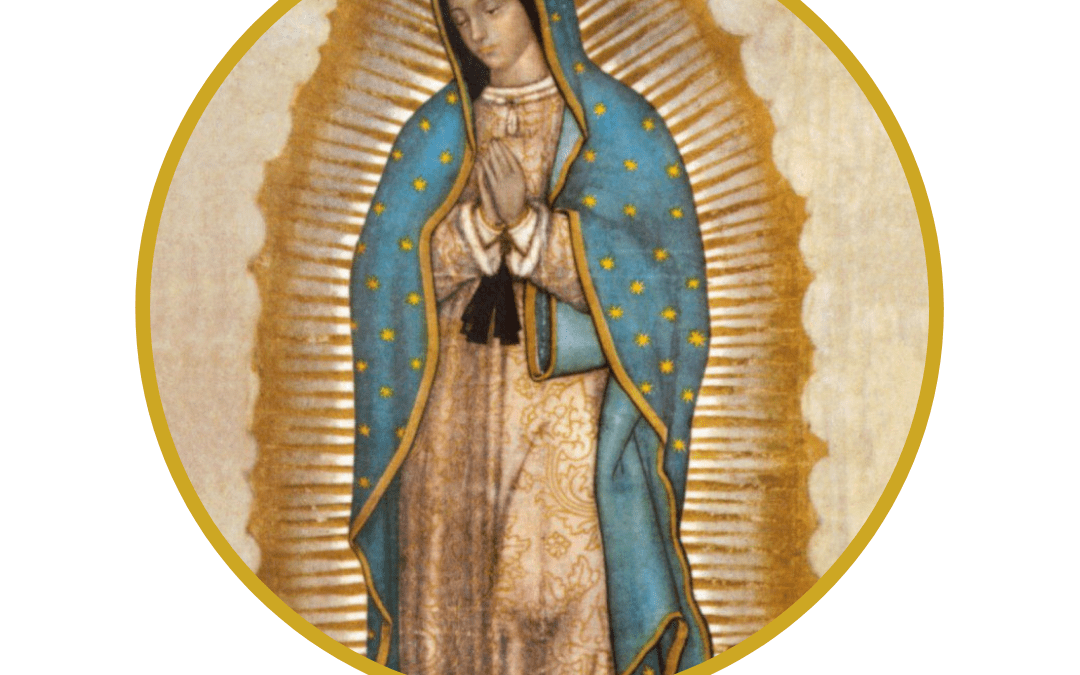9 December: Saint Juan Diego and 12 December: Our Lady of Guadalupe. It is fitting to celebrate these two feast days together. The beautiful story of Juan Diego and Our Lady of Guadalupe is well known. A poor Indian man named Juan Diego was walking for many miles to attend Mass on December 9, 1531. Near a hill called Tepeyac, he heard beautiful music that sounded like birds. A radiant cloud appeared, and in it stood an Indian maiden dressed like an Aztec princess. The lady spoke to him and sent him to the bishop of Mexico to ask for a chapel to be built in that place. The bishop was skeptical and told Juan to ask for a sign. Juan promised to do so but that day his uncle became very ill and Juan stayed to care for him instead. When Juan later went to the priest, he took the long way around the mountain, trying to avoid the lady he had let down. The lady appeared to Juan along his detour and chided him for not coming to her for help. “Am I not here, I who am your mother?” The lady assured Juan that his uncle would recover. For the bishop’s sign, she instructed Juan to gather roses in his cloak, called a tilma. The roses were miraculously growing out of season on the mountaintop. When Juan opened his tilma in the bishop’s presence on December 12, the roses fell to the ground, and the bishop sank to his knees in reverence. On the tilma was an image of Our Lady, exactly as she had appeared at Tepeyac. The symbolism of Our Lady of Guadalupe’s image was obvious to the Native Mexicans: she is more powerful than the Aztec gods, yet she herself is not God. Our Lady of Guadalupe did not appear again, for her mission was complete. She had come to offer faith, hope and consolation to the oppressed natives of Mexico and to reconcile them with their Spanish rulers. She put an end to the bloody human sacrifice of the Aztecs and converted ten million natives in the next 10 years. The church she asked for was built and remains there today, in a suburb of Mexico City. Juan Diego’s tilma, woven from cactus fibers (with a shelf-life of just 30 years) remains miraculously preserved there. With the Bishop’s permission, Juan Diego moved to a small room attached to the chapel that housed the sacred image. There he cared for the tilma and church. Millions made pilgrimages to see the miraculous tilma, and to honor Our Lady of Guadalupe. Great miracles continue to occur, even today. In 1945, Pope Pius XII decreed Our Lady of Guadalupe to be the “Patroness of all the Americas.” Juan Diego died on May 30, 1548, at the age of 74. In 1990 he was declared Blessed and was canonized in 2002. Saint Pope John Paul II praised Juan Diego for his simple faith and considered him a model of humility for all.
Ideas for celebrating these feast days at home:
- Join POP for a special candlelit 6.30a Rorate Mass on Saturday, 12 December
- Mexican-inspired dinner menu: tamales or tacos, black beans and rice, guacamole and chips. Make Mexican hot chocolate with Mexican wedding cakes for dessert! Click here for more recipe ideas.
- Roses: buy dark pink roses or make tissue paper roses to place on your dinner table in memory of the Castilian roses that Juan Diego picked on the mountainside.
- Decorate Tilmas: turn brown paper bags into homemade “tilmas” in honor of Our Lady of Guadalupe. Click here for idea.
- FORMED has a wonderful children’s video about Juan Diego and Guadalupe – available for free using your parishioner account! Click here to watch.
- Prayers to Our Lady of Guadalupe can be found at this link.
- If you have a statue of Our Lady, decorate it beautifully with flowers, Christmas lights, or candles in honor of this special feast day. You can encourage devotion to the miraculous image of Our Lady of Guadalupe by purchasing one to display in your home. Or, you can print one here.
- Click here to learn more about the amazing symbolism of Our Lady’s image on the tilma.
